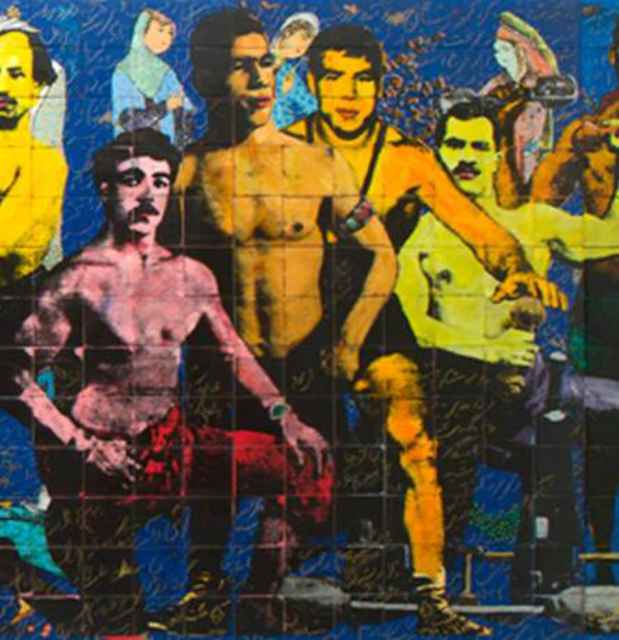Khosrow Hassanzadeh "Haft Khan: The Seven Labors of Rostam"
Leila Heller Gallery (Chelsea)

This event has ended.
Hassanzadeh’s murals are enormous in size: the largest is more than 6 feet tall and nearly 28 feet long. Inspired by Iranian traditions of manhood that existed in a pre-revolutionized Iran, Hassanzadeh combines Persian visual traditions with pop representations of the once-celebrated icon of the wrestler.
Hassanzadeh finds inspiration from the Haft Khan, a story from the epic Persian poem Shahnameh (The Book of Kings). The story tells of Rostam, an Iranian Hercules, who must go through seven quests, or labors, to save his sovereign from demons. He is historicized as courageous and chivalrous, as the champion of all champions. As Varzesh-e Pahlavani, Persian folk wrestling, became popularized in 19th-century Iran, the wrestler, or pahlavan, became the embodiment of Rostam for sharing similar characteristics.
As the artist explains, “Wrestlers used to be an integral part of our culture. They were the caretakers of society; they were powerful men, strong men who were society’s protectors and providers. They helped people in need—whether helping to organize wedding ceremonies and memorials, or organizing relief during earthquakes. This culture has now been lost.”
Hassanzadeh pays homage to this culture of the past, along with several other visual aspects of Iranian culture, in his work. The largest work in the show, Haft Khan, 2010, a nearly 28 foot long ceramic mural, consists of 728 tiles colored in an intensely saturated cerulean—a reference to the abundant tiles that cover Iran and the blue that covers the domes of mosques and colors the tiled walls of their interiors. Using less traditional materials, such as silkscreen and resin, he layers on top of the tiles detailed figures reminiscent of the characters seen in Persian miniature paintings, delicately intertwined with gold calligraphic Farsi markings. The work’s final layer departs from the Persian artistic tradition. Men colored in bold blues, vibrant yellows, and deep reds flex their muscles, congregate, and pose to show off their masculine athletic forms. These wrestlers are presented as faded figures of a vintage photograph as to emphasize them as only a memory of Iran. Yet by placing such figures on top of the mosque-like tiles, the artist brings to mind present day Iran — a country where there is an almost devotional struggle for the pahlavan ideals of freedom, courage, and a righteous code of conduct.
Remember, 2010, presents similar pahlavans as seen in Haft Khan. Yet behind these figures are not Persian miniatures, but framed images of the iconic figures Imam Ali and the Iranian Olympic wrestling champion, Takhti. The framed images lie on a background covered in whirling Farsi script, which repeats “Ya Ali Madad,” or “help me Ali,” a Shiite prayer once often when one undertaking a difficult task and needed the help of Ali. By combining images of the wrestler Takhti with a religious figure, Hassanzadeh praises the figures and traditions lost to the Iranian Revolution.
As Dr. Shiva Balaghi, a historian of the modern Middle East at Brown University, writes in the catalogue essay, “In his art, Hassanzadeh works with the pictorial language that surrounds him. He recombines the familiar to create art that reasserts notions of manhood taken from Iranian history and popular culture. In recasting masculinity, Hassanzadeh works with traditional Iranian cultural forms—archival photographs from the zurkhaneh, the illuminated manuscript, and calligraphy. His intervention on gender and representation is ultimately a pictorial conversation that recasts Iranian cultural paradigms.”
Media
Schedule
from March 01, 2012 to March 31, 2012
Opening Reception on 2012-03-01 from 18:00 to 20:00